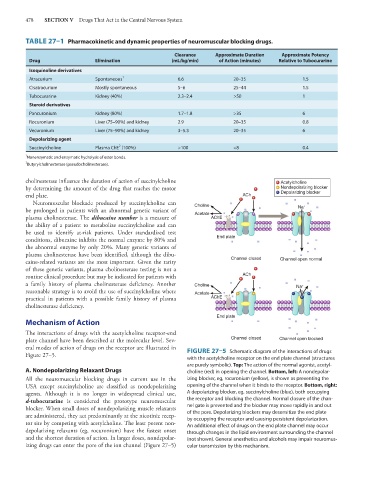Page 492 - Basic _ Clinical Pharmacology ( PDFDrive )
P. 492
478 SECTION V Drugs That Act in the Central Nervous System
TABLE 27–1 Pharmacokinetic and dynamic properties of neuromuscular blocking drugs.
Clearance Approximate Duration Approximate Potency
Drug Elimination (mL/kg/min) of Action (minutes) Relative to Tubocurarine
Isoquinoline derivatives
Atracurium Spontaneous 1 6.6 20–35 1.5
Cisatracurium Mostly spontaneous 5–6 25–44 1.5
Tubocurarine Kidney (40%) 2.3–2.4 >50 1
Steroid derivatives
Pancuronium Kidney (80%) 1.7–1.8 >35 6
Rocuronium Liver (75–90%) and kidney 2.9 20–35 0.8
Vecuronium Liver (75–90%) and kidney 3–5.3 20–35 6
Depolarizing agent
2
Succinylcholine Plasma ChE (100%) >100 <8 0.4
1
Nonenzymatic and enzymatic hydrolysis of ester bonds.
2 Butyrylcholinesterase (pseudocholinesterase).
cholinesterase influence the duration of action of succinylcholine Acetylcholine
by determining the amount of the drug that reaches the motor Nondepolarizing blocker
end plate. ACh Depolarizing blocker
Neuromuscular blockade produced by succinylcholine can Choline
be prolonged in patients with an abnormal genetic variant of Na +
plasma cholinesterase. The dibucaine number is a measure of Acetate AChE
the ability of a patient to metabolize succinylcholine and can
be used to identify at-risk patients. Under standardized test
conditions, dibucaine inhibits the normal enzyme by 80% and End plate
the abnormal enzyme by only 20%. Many genetic variants of
plasma cholinesterase have been identified, although the dibu-
caine-related variants are the most important. Given the rarity Channel closed Channel open normal
of these genetic variants, plasma cholinesterase testing is not a
routine clinical procedure but may be indicated for patients with ACh
a family history of plasma cholinesterase deficiency. Another Choline Na +
reasonable strategy is to avoid the use of succinylcholine where Acetate
practical in patients with a possible family history of plasma AChE
cholinesterase deficiency.
End plate
Mechanism of Action
The interactions of drugs with the acetylcholine receptor-end
plate channel have been described at the molecular level. Sev- Channel closed Channel open blocked
eral modes of action of drugs on the receptor are illustrated in
Figure 27–5. FIGURE 27–5 Schematic diagram of the interactions of drugs
with the acetylcholine receptor on the end plate channel (structures
are purely symbolic). Top: The action of the normal agonist, acetyl-
A. Nondepolarizing Relaxant Drugs choline (red) in opening the channel. Bottom, left: A nondepolar-
All the neuromuscular blocking drugs in current use in the izing blocker, eg, rocuronium (yellow), is shown as preventing the
USA except succinylcholine are classified as nondepolarizing opening of the channel when it binds to the receptor. Bottom, right:
agents. Although it is no longer in widespread clinical use, A depolarizing blocker, eg, succinylcholine (blue), both occupying
d-tubocurarine is considered the prototype neuromuscular the receptor and blocking the channel. Normal closure of the chan-
blocker. When small doses of nondepolarizing muscle relaxants nel gate is prevented and the blocker may move rapidly in and out
are administered, they act predominantly at the nicotinic recep- of the pore. Depolarizing blockers may desensitize the end plate
by occupying the receptor and causing persistent depolarization.
tor site by competing with acetylcholine. The least potent non- An additional effect of drugs on the end plate channel may occur
depolarizing relaxants (eg, rocuronium) have the fastest onset through changes in the lipid environment surrounding the channel
and the shortest duration of action. In larger doses, nondepolar- (not shown). General anesthetics and alcohols may impair neuromus-
izing drugs can enter the pore of the ion channel (Figure 27–5) cular transmission by this mechanism.

